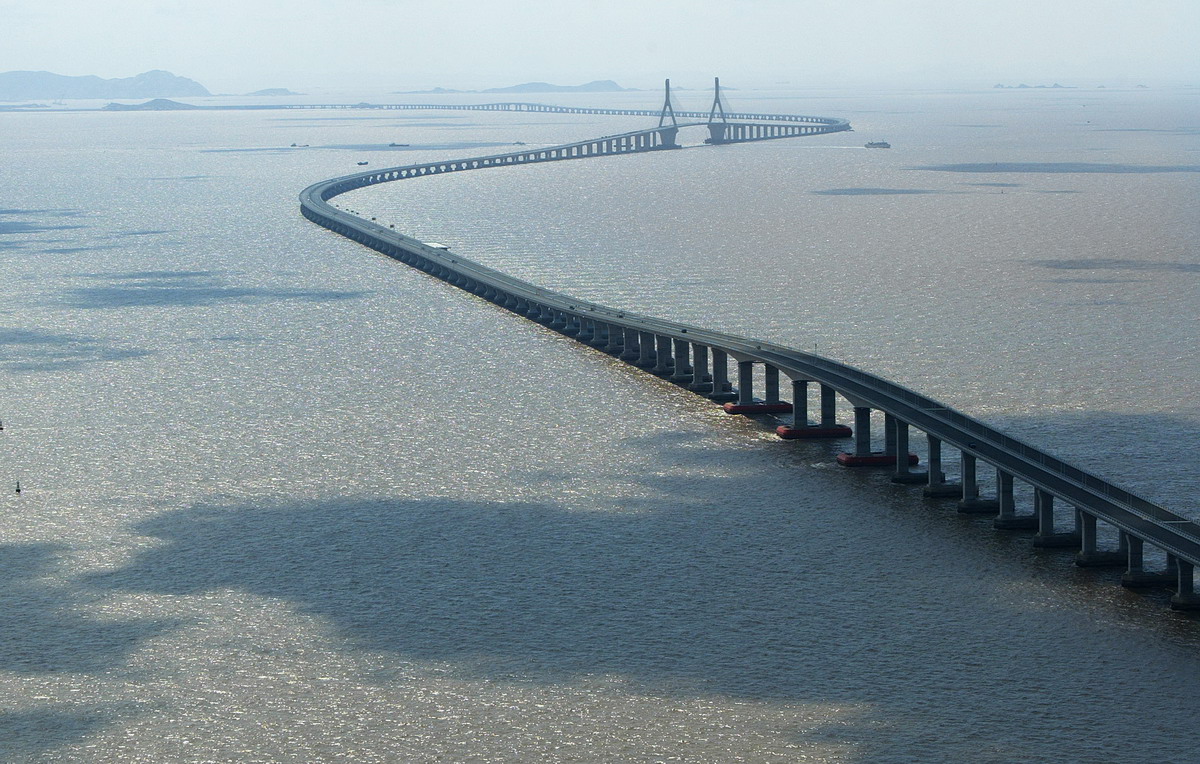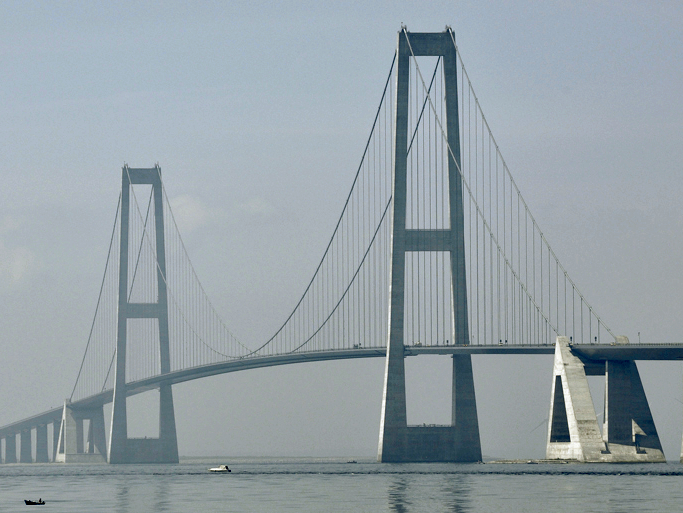|
Masnedsund Bridge
The Masnedsund Bridge ( da, Masnedsundbroen) is a bascule bridge that crosses Masnedsund between the islands Masnedø and Zealand (Denmark), Zealand ( da, Sjælland) in Denmark. It carries road and railway traffic, as well as pedestrians and bicycles. Together with Storstrøm Bridge it connects Falster and Zealand and was the main road connection between the islands until the Farø Bridges were opened in 1985. It was officially opened on 6 August 1937, and replaced an older railway bridge that was opened on 15 January 1884, and a ferry. The new bridges were commissioned by the Danish state railways (Danske Statsbaner) and designed by them with assistance from Christiani & Nielsen A/S of Copenhagen. Construction was by Dorman Long and company, with Christiani & Nielsen acting as sub-contractors responsible for foundations and reinforced concrete sections. The contract for the work was signed on 13 May 1933. The bridge is 201 metres long and 8.8 metres wide, with main span of 25 metr ... [...More Info...] [...Related Items...] OR: [Wikipedia] [Google] [Baidu] |
Folketidende
''Folketidende'' was a Norwegian newspaper published in Mandal between 1865 and 1879. History and profile ''Folketidende'' was founded in 1865 by Søren Jaabæk. The paper was a four-page publication. It focused on small government Libertarian conservatism, also referred to as conservative libertarianism and conservatarianism, is a political and social philosophy that combines conservatism and libertarianism, representing the libertarian wing of conservatism and vice ver ... and liberalist politics. It went defunct in 1879. References Defunct newspapers published in Norway Mandal, Norway Norwegian-language newspapers Newspapers established in 1865 Publications disestablished in 1879 Mass media in Vest-Agder 1865 establishments in Norway 1879 disestablishments in Norway {{italic title ... [...More Info...] [...Related Items...] OR: [Wikipedia] [Google] [Baidu] |
Railway Bridges In Denmark
Rail transport (also known as train transport) is a means of transport that transfers passengers and goods on wheeled vehicles running on rails, which are incorporated in tracks. In contrast to road transport, where the vehicles run on a prepared flat surface, rail vehicles (rolling stock) are directionally guided by the tracks on which they run. Tracks usually consist of steel rails, installed on sleepers (ties) set in ballast, on which the rolling stock, usually fitted with metal wheels, moves. Other variations are also possible, such as "slab track", in which the rails are fastened to a concrete foundation resting on a prepared subsurface. Rolling stock in a rail transport system generally encounters lower frictional resistance than rubber-tyred road vehicles, so passenger and freight cars (carriages and wagons) can be coupled into longer trains. The operation is carried out by a railway company, providing transport between train stations or freight customer faciliti ... [...More Info...] [...Related Items...] OR: [Wikipedia] [Google] [Baidu] |
Road Bridges In Denmark
A road is a linear way for the conveyance of traffic that mostly has an improved surface for use by vehicles (motorized and non-motorized) and pedestrians. Unlike streets, the main function of roads is transportation. There are many types of roads, including parkways, avenues, controlled-access highways (freeways, motorways, and expressways), tollways, interstates, highways, thoroughfares, and local roads. The primary features of roads include lanes, sidewalks (pavement), roadways (carriageways), medians, shoulders, verges, bike paths (cycle paths), and shared-use paths. Definitions Historically many roads were simply recognizable routes without any formal construction or some maintenance. The Organization for Economic Co-operation and Development (OECD) defines a road as "a line of communication (travelled way) using a stabilized base other than rails or air strips open to public traffic, primarily for the use of road motor vehicles running on their own wheels", which i ... [...More Info...] [...Related Items...] OR: [Wikipedia] [Google] [Baidu] |
Bascule Bridges
A bascule bridge (also referred to as a drawbridge or a lifting bridge) is a moveable bridge with a counterweight that continuously balances a span, or leaf, throughout its upward swing to provide clearance for boat traffic. It may be single- or double-leafed. The name comes from the French term for balance scale, which employs the same principle. Bascule bridges are the most common type of movable span because they open quickly and require relatively little energy to operate, while providing the possibility for unlimited vertical clearance for marine traffic. History Bascule bridges have been in use since ancient times, but until the adoption of steam power in the 1850s, very long, heavy spans could not be moved quickly enough for practical application. Types There are three types of bascule bridge and the counterweights to the span may be located above or below the bridge deck. The fixed-trunnion (sometimes a "Chicago" bascule) rotates around a large axle that raises the sp ... [...More Info...] [...Related Items...] OR: [Wikipedia] [Google] [Baidu] |
Bridges In Denmark
A bridge is a structure built to span a physical obstacle (such as a body of water, valley, road, or rail) without blocking the way underneath. It is constructed for the purpose of providing passage over the obstacle, which is usually something that is otherwise difficult or impossible to cross. There are many different designs of bridges, each serving a particular purpose and applicable to different situations. Designs of bridges vary depending on factors such as the function of the bridge, the nature of the terrain where the bridge is constructed and anchored, and the material used to make it, and the funds available to build it. The earliest bridges were likely made with fallen trees and stepping stones. The Neolithic people built boardwalk bridges across marshland. The Arkadiko Bridge (dating from the 13th century BC, in the Peloponnese) is one of the oldest arch bridges still in existence and use. Etymology The ''Oxford English Dictionary'' traces the origin of the ... [...More Info...] [...Related Items...] OR: [Wikipedia] [Google] [Baidu] |
List Of Bridges
The list of bridges is a link page for any bridges that are notable enough to have an article, or that are likely to have an article in the future, sorted alphabetically by country. Lists of bridges by country Afghanistan Albania Algeria * Ouadi El Roukham Bridge Andorra Argentina *General Artigas Bridge *General Belgrano Bridge *Ingeniero Ballester Dam *Integration Bridge * Libertador General San Martín Bridge * Neuquén-Cipolletti bridges * Paso de los Libres – Uruguaiana International Bridge *Puente de la Mujer * Puente Transbordador * Puente Valentín Alsina *Rosario-Victoria Bridge *Salto Grande Bridge *San Roque González de Santa Cruz Bridge * Tancredo Neves Bridge *Zárate–Brazo Largo Bridge Armenia Aruba Australia * Albert Bridge, Brisbane *Alexandra Bridge, Rockhampton *Alfords Point Bridge, Sydney *Algebuckina Bridge, near Oodnadatta, South Australia *Andrew Nixon Bridge, St George *Anzac Bridge, Sydney *Batman Bridge, Launceston * Birkenhead Bri ... [...More Info...] [...Related Items...] OR: [Wikipedia] [Google] [Baidu] |
List Of Bridges In Denmark
This is a list of bridges and viaducts in Denmark, including those for pedestrians and vehicular traffic. Major road and railway bridges Alphabetical list * Aggersund Bridge * Alssund Bridge * Farø Bridges * Fehmarn Belt Fixed Link: A bridge was proposed as one means of spanning the Fehmarn Belt (to Germany) * Frederick IX Bridge * Great Belt Fixed Link * Guldborgsund Bridge * Knippelsbro * Langebro * Langeland Bridge * Lille Langebro * Limfjordsbroen * Little Belt Bridge * Little Belt Bridge (1970) * Masnedsund Bridge * Munkholm Bridge * Oresund Bridge (Connects to Sweden) * Queen Alexandrine Bridge * Ravning Bridge (demolished) * Sallingsund Bridge * Siøsund Bridge * Storstrøm Bridge * Svendborgsund Bridge * Teglværksbroen * Vejle Fjord Bridge * Vilsund Bridge Notes and references * * Others references See also * List of tunnels of the Faroe Islands * Transport in Denmark * Transport in Greenland * Rail transport in Denmark * Motorways in Denmark ... [...More Info...] [...Related Items...] OR: [Wikipedia] [Google] [Baidu] |
Per Aarsleff (company)
Per Aarsleff Aktieselskab, A/S is a Danish civil engineering and construction company. History It was founded in 1947 by Per Aarsleff. Organization The company is based in Aabyhøj in the western parts of Aarhus, Denmark. It has around 6,500 staff worldwide. The Aarsleff Group is the largest producer of Deep foundation, concrete piles in Europe. The Danish subsidiary producer of precast concrete piles ''Centrum Pæle'' was founded in 1966, and is based in the city of Vejle. United Kingdom Per Aarsleff (UK) Ltd, known as Aarsleff Ground Engineering (previously Aarsleff Piling), is based in New Balderton in Newark-on-Trent. The UK site also contains Centrum Pile Ltd, and mainly makes concrete piles. The UK subsidiary was founded in 1991 and is the leading supplier of precast concrete piles in the UK. Products The company has been asked to provide the concrete deep foundations for civil engineering projects, such as for bridges or wind farms. For windfarms, it has worked with Bi ... [...More Info...] [...Related Items...] OR: [Wikipedia] [Google] [Baidu] |
TV Øst
Television, sometimes shortened to TV, is a telecommunication medium for transmitting moving images and sound. The term can refer to a television set, or the medium of television transmission. Television is a mass medium for advertising, entertainment, news, and sports. Television became available in crude experimental forms in the late 1920s, but only after several years of further development was the new technology marketed to consumers. After World War II, an improved form of black-and-white television broadcasting became popular in the United Kingdom and the United States, and television sets became commonplace in homes, businesses, and institutions. During the 1950s, television was the primary medium for influencing public opinion.Diggs-Brown, Barbara (2011''Strategic Public Relations: Audience Focused Practice''p. 48 In the mid-1960s, color broadcasting was introduced in the U.S. and most other developed countries. The availability of various types of archival storag ... [...More Info...] [...Related Items...] OR: [Wikipedia] [Google] [Baidu] |




